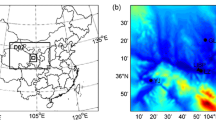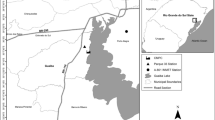Abstract
A neural network model was developed to predict the short-term (<150 s) concentration distributions of aerosols released from point sources over very short time periods (approximately 2 s). The model was based on data from field experiments covering a wide range of meteorological conditions. The study focused on relative dispersion about the puff centroid, with puff/cloud meander and large-scale gusts not being considered. The artificial neural network (ANN) model included explicitly a number of meteorological and turbulence parameters, and was compared with predictions from two Gaussian-based puff models to the measurements of four independent trials representing different stability conditions. The performance of the neural network model was comparable (in stable conditions) or better (in unstable and neutral conditions) than these two models when high concentration predictions were considered. Simulations of concentration distributions under different stability conditions were also generated using the developed neural network model, with the result that Gaussian distributions provided good descriptors for puff dispersion in the downwind and crosswind directions, and for particles close to the centroid in the vertical when dealing with short dispersion times.
Similar content being viewed by others
References
Andrews WS, Cao X, Roy G, Forand L, Potvin G (2003) Field data collection in support of dispersion modelling. In: Proceedings of battlespace atmospheric and cloud impacts on military operations conference 2003, Monterey, CA, NRL, September 2003
Andrews WS, Cao X, Roy G, Forand L, Potvin G (2005) Modelling the dispersion of aerosols from point sources. In: Proceedings of battlespace atmospheric and cloud impacts on military operations conference 2005, Monterey, CA, NRL, October 2005
Arya SP (1999) Air pollution meteorology and dispersion. Oxford University Press, New York, pp 310
Ayres SD, DeSutter S (1995) Combined Obscuration Model for Battlefield Induced Contaminants (COMBIC92) Model Documentation. U.S. Army Research Laboratory, Battlefield Environment Directorate, White Sands Missile Range, NM 88002-5501, 251 pp
Bissonnette LR, Roy G, Vallee G, Cantin S (2003) Mesures lidar d’un panache d’insecticide ‘emanant d’une source continue. RDDC Valcartier ECR 2003–273, 32 pp
Cappa C, Anfossi D (2001) Short-term prediction of urban NO2 pollution by means of articial neural networks. Int J Environ Pollut 15(5): 483–496
Chang MPJL, Font CO, Gilbreath GC, Oh E (2007) Humidity’s influence on visible region refractive index structure parameter Cn2. Appl Opt 46(13): 2453–2459
De Haan P (1999) On the use of density kernels for concentration estimates within particle and puff dispersion models. Atmos Environ 33: 2007–2021
De Hann P, Rotach MW (1998) A novel approach to atmospheric dispersion modelling: the puff-particle model. Q J Roy Meteorol Soc 124: 2771–2792
DeVito TJ, Cao X, Roy G, Costa JR, Andrews WS (2009) Modelling aerosol concentration distributions from transient (puff) sources. Can J Civ Eng 36(5): 911–922
Dwinnell W (1998) Modelling methodology 2: model input selection. PC AI 12(1): 23–26
Forand JL (1999) The L(W)WKD marine boundary layer model. Version 7.09, DREV-TR-999-099, Valcartier, 106 pp
Forand JL (2003) Data analysis from fast sonic anemometer and hygrometer, meteorological and micrometeorological. DRDC Valcartier TR 2003-048, 46 pp
Guardani R, Nascimento CAO (2004) Neural network-based study for prediction ground-level ozone concentration in large urban areas, applied to the Sao Paulo metropolitan area. Int J Environ Pollut 22(4): 441–459
Hanna SR, Briggs GA, Hosker RP Jr (1982) Handbook on atmospheric diffusion. National Technical Information Centre U.S. Department of Energy, Springfield, 102 pp
Islitzer NF, Slade DH (1968) Diffusion and transport experiments. In: Slade DH (ed) Meteorology and atomic energy TID-24190. USAEC, pp 163–175
Minai AA, Williams RD (1990) Acceleration of back-propagation through learning rate and momentum adaptation. In: Proceedings of the IEEE/INNS international joint conference on neural networks- 90-WASH-DC, Washington, DC 1, pp 676–679
Mohan M, Siddiqui TA (1997) An evaluation of dispersion coefficients for use in air quality models. Boundary-Layer Meteorol 84: 177–206
NEURALWARE (2003) Reference guide: NeuralWorks Professional II/Plus and NeuralWorks Explorer, Pittsburgh, PA, 283 pp
Patterson DW (1998) Artificial neural networks: theory and applications. Simon & Schuster, New York, pp 400
Tatarskii VI (1961) Wave propagation in a turbulent medium. (Trans: Russian by R.A. Silverman). McGraw-Hill, New York, pp 285
Wasserman PD (1993) Advanced methods in neural computing. Wiley, New York, pp 250
Wilson JD, Sawford BL (1996) Review of Lagrangian stochastic models for trajectories in the turbulent atmosphere. Boundary-Layer Meteorol 78: 191–210
Yi J, Prybutok R (1996) A neural network model forecasting for prediction of daily maximum ozone concentration in an industrialised urban area. Environ Pollut 92(30): 349–357
Author information
Authors and Affiliations
Corresponding author
Rights and permissions
About this article
Cite this article
Cao, X., Roy, G. & Andrews, W.S. Modelling the Concentration Distributions of Aerosol Puffs Using Artificial Neural Networks. Boundary-Layer Meteorol 136, 83–103 (2010). https://doi.org/10.1007/s10546-010-9501-4
Received:
Accepted:
Published:
Issue Date:
DOI: https://doi.org/10.1007/s10546-010-9501-4




